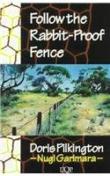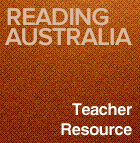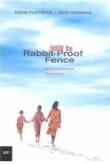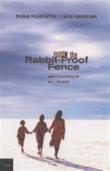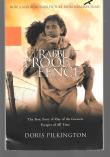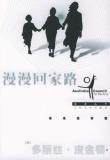AustLit
Latest Issues
AbstractHistoryArchive Description
'The film Rabbit-Proof Fence is based on this true account of Doris Nugi Garimara Pilkington's mother Molly, who as a young girl led her two sisters on an extraordinary 1,600 kilometre walk home. Under Western Australia's invidious removal policy of the 1930s, the girls were taken from their Aboriginal family at Jigalong on the edge of the Little Sandy Desert, and transported halfway across the state to the Native Settlement at Moore River, north of Perth...
The three girls - aged 8, 11 and 14 - managed to escape from the settlement's repressive conditions and brutal treatment. Barefoot without provisions or maps, they set out to find the rabbit-proof fence, knowing it passed near their home in the north. Tracked by native police and search planes, they hid in terror, surviving on bush tucker, desperate to return to the world they knew.
The journey to freedom - longer than many of the legendary walks of [the Australian nation's] explorer heroes... told from family recollections, letters between the authorities and the Aboriginal Protector, and ... newspaper reports of the runaway children.' Source: Publisher's blurb
Adaptations
-
form
y
 Rabbit-Proof Fence
( dir. Phillip Noyce
)
Australia
:
Rumbalara Films
Olsen Levy Productions
,
2002
Z919523
2002
single work
film/TV
(taught in 15 units)
Rabbit-Proof Fence
( dir. Phillip Noyce
)
Australia
:
Rumbalara Films
Olsen Levy Productions
,
2002
Z919523
2002
single work
film/TV
(taught in 15 units)
Based on real life events that occurred in 1931, Rabbit-Proof Fence is the story of three mixed-race Aboriginal children who are forcibly abducted from their mothers by the Western Australian government. Molly (aged fourteen), her sister Daisy (aged eight), and their cousin Gracie (aged ten) are taken from their homes at Jigalong, situated in the Pilbara region of Western Australia, at the orders of the Protector of Aborigines, A.O. Neville, and sent to an institution at Moore River to be educated and trained as domestic servants. After a few days, Molly leads the other two girls in an escape. What ensues is an epic journey that tests the girls' will to survive and their hope of finding the rabbit-proof fence to guide them home.
Although they are pursued by the institution's Aboriginal tracker and the police, Molly knows enough about bush craft to help them hide their tracks. They head east in search of the world's longest fence - built to keep rabbits out - because Molly knows that this will lead them back to Jigalong. Over the course of nine weeks, the girls walk almost 2,400 kilometres before Gracie is captured attempting to catch a train. Molly and Daisy avoid capture but eventually collapse from exhaustion on the saltpans not far from Jigalong. When they wake, they see the spirit bird, an eagle, flying overhead. Its significance gives the girls the extra energy they need and they are able to make it back to their home.
Reading Australia
This work has Reading Australia teaching resources.
Unit Suitable For
Unit Suitable For
AC: Year 9 (NSW Stage 5)
Themes
Aboriginality, bravery, coming of age, family, hardship, home, identity, importance of story, Power, resistance, Stolen Generations, survival
General Capabilities
Critical and creative thinking, Ethical understanding, Information and communication technology, Intercultural understanding, Literacy, Numeracy, Personal and social
Notes
-
This project has been assisted by the Australian Government through the Australia Council, its arts funding and advisory board.
-
Dedication: To all of my mother's and aunty's children and their descendants for inspiration, encouragement and determination.
Publication Details of Only Known VersionEarliest 2 Known Versions of
Other Formats
- Sound recording.
- Large print.
Works about this Work
-
Fever in the Archive
single work
criticism
— Appears in: Humanities Australia , no. 5 2014; (p. 23-35)Anna Haebich investigates how the West Australian Department of Indigenous Affairs archives (1898-1972) have been utilised by Indigenous writers/researchers.
-
y
 Reading Our Way : An Indigenous-centred Model for Engaging with Australian Indigenous Literature
Kelvin Grove
:
2021
23964231
2021
single work
thesis
Reading Our Way : An Indigenous-centred Model for Engaging with Australian Indigenous Literature
Kelvin Grove
:
2021
23964231
2021
single work
thesis
'Indigenous writers’ works have been subjugated in a context of power and domination by many historical publishing frameworks. However, through the act of writing many Indigenous writers assert their sovereign power and make clear interventions designed to challenge the status quo. This thesis argues for the further shifting of power from the majority non-Indigenous Australian literary sector to Indigenous writers and their communities through the development of an expansive model for reading Australian Indigenous literature.
'Using a theoretical framework of Indigenous ways of being, knowing and doing this thesis proposes a reading method based on Indigenous paradigms, constituted by Indigenous ontologies, epistemologies and axiologies. The proposed reading method is then operationalised in the reading of five texts written by Australian Indigenous women and non-binary writers: We Are Going by Oodgeroo Noonuccal (1964), Follow the Rabbit-Proof Fence by Doris Pilkington (1996), Carpentaria by Alexis Wright (2006), Heat and Light by Ellen van Neerven (2014), and The Yield by Tara June Winch (2019). New understandings and knowledges are derived from the works, derived from reading with responsibility and accountability to family, kin and community, reading for songlines and relations in the text, and reading with Indigenous notions of time and with the understanding that Indigenous literature is knowledge.
'The results of these readings are compared with the history of critical reception across four areas of the Australian literary sector, inclusive of the Australian media, published scholarly work, and the Australian literary and Indigenous literary industries. Differences and similarities confirm that reading from within Indigenous research paradigms results in a reorientation of Australian Indigenous literature across the literary sector. From this process, an Indigenous-centred reading approach is documented and an Indigenous-centred model for reading Australian Indigenous literature is further synthesised.
'The thesis builds on the work of Indigenous scholars such as Anita Heiss, Sandra Phillips, Jeanine Leane and Alexis Wright and makes a critical intervention within the Australian literary sector and especially the academy. The developed model places power back into the hands of Indigenous writers and readers, storytellers and storyreceivers and provides expansive ways of reading and a productive tension through which new knowledge can be produced for the benefit of Indigenous writers and their communities.'
Source: QUT ePrints.
-
y
 Neurocognitive Interpretations of Australian Literature : Criticism in the Age of Neuroawareness
London
:
Routledge
,
2021
21558011
2021
multi chapter work
criticism
Neurocognitive Interpretations of Australian Literature : Criticism in the Age of Neuroawareness
London
:
Routledge
,
2021
21558011
2021
multi chapter work
criticism
'This unique book on neurocognitive interpretations of Australian literature covers a wide range of analyses by discussing Australian Literary Studies, Aboriginal literary texts, women writers, ethnic writing, bestsellers, neurodivergence fiction, emerging as well as high profile writers, literary hoaxes and controversies, book culture, LGBTIQA+ authors, to name a few. It eclectically brings together a wide gamut of cognitive concepts and literary genres at the intersection of Australian literary studies and cognitive literary studies in the first single-author volume of its kind. It takes Australian Literary Studies into the age of neuroawareness and provides new pathways in contemporary criticism.'
Source: Publisher's blurb.
-
Genocide and Ecocide
2020
single work
criticism
— Appears in: Packing Death in Australian Literature : Ecocides and Eco-Sides 2020; (p. 21-43) -
The Stolen Generations of Australia : Narratives of Loss and Survival
2020
single work
criticism
— Appears in: International Research in Children’s Literature , December vol. 13 no. 2 2020; (p. 231–241)
-
[Review] Follow the Rabbit-proof Fence
2002
single work
review
— Appears in: Reading Time : The Journal of the Children's Book Council of Australia , August vol. 46 no. 3 2002; (p. 27)
— Review of Follow the Rabbit-Proof Fence 1996 single work biography -
[Review] Follow the Rabbit-proof Fence
2002
single work
review
— Appears in: Voice : A Journal of Comment and Review , June no. 2 2002; (p. 34-35)
— Review of Follow the Rabbit-Proof Fence 1996 single work biography -
Lapses Mar the Retelling of Aboriginal Girls' Story
1997
single work
review
— Appears in: Antipodes , December vol. 11 no. 2 1997; (p. 119)
— Review of Follow the Rabbit-Proof Fence 1996 single work biography -
Paperbacks
2002
single work
review
— Appears in: Canberra Sunday Times , 17 February 2002; (p. 51)
— Review of Machines for Feeling 2001 single work novel ; Regret 2002 single work novel ; Follow the Rabbit-Proof Fence 1996 single work biography ; Finding Ullagundahi Island 2001 single work novel -
Traversing the Personal
2002
single work
review
— Appears in: Australian Book Review , March no. 239 2002; (p. 33-34)
— Review of Finding Ullagundahi Island 2001 single work novel ; Follow the Rabbit-Proof Fence 1996 single work biography ; Full Circle : From Mission to Community : A Family Story 2001 single work autobiography -
Telling the Nation
2002
single work
criticism
— Appears in: Cultural Studies Review , November vol. 8 no. 2 2002; (p. 157-178) '..identifying, seeking out and evaluating the distinguishing features of Australian culture or Australian people remains a popular activity. This essay discusses some recent books that do so, focusing on their underlying assumptions and motivations, and attempting to put them into historical perspective.' (p.157) -
BookMarks
2003
single work
column
— Appears in: The Courier-Mail , 26 April 2003; (p. 6) -
'Echoes Across the Flats' : Storytelling and Phillip Noyce's Rabbit Proof Fence (2002)
2002
single work
essay
— Appears in: Southerly , vol. 62 no. 3 2002; (p. 107-117) -
The Battle Against Forgetting
2002
single work
criticism
— Appears in: The Sydney Morning Herald , 11 April 2002; (p. 14) -
Rabbit Proof Fence Heroine's Unfinished Business
2004
single work
column
— Appears in: The Australian , 16 January 2004; (p. 3)
Awards
- 2003 shortlisted One Book One Brisbane
- Moore River, Guilderton - Gingin area, Southwest Western Australia, Western Australia,
- Western Australia,
- Jigalong, Pilbara area, North Western Australia, Western Australia,
- Moore River Native Settlement (1918-1951), Western Australia,
- Western Australia,
- 1930s

